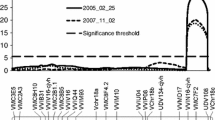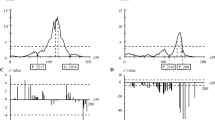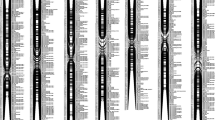Abstract
Peach powdery mildew is one of the major diseases of the peach. Various sources of resistance to PPM have thus been identified, including the single dominant locus Vr2 carried by the peach rootstock ‘Pamirskij 5’. To map Vr2, a linkage map based on microsatellite markers was constructed from the F2 progeny (WP2) derived from the cross ‘Weeping Flower Peach’ × ‘Pamirskij 5’. Self-pollinations of the parents were also performed. Under greenhouse conditions, all progenies were scored after artificial inoculations in two classes of reactions to PPM (resistant/susceptible). In addition to Vr2, WP2 segregated for three other traits from ‘Weeping Flower Peach’: Rm1 for green peach aphid resistance, Di2 for double-flower and pl for weeping-growth habit. With their genomic locations unknown or underdocumented, all were phenotyped as Mendelian characters and mapped: Vr2 mapped at the top of LG8, at 3.3 cM, close to the CPSCT018 marker; Rm1 mapped at the bottom of LG1, at a position of 116.5 cM, cosegregating with the UDAp-467 marker and in the same region as Rm2 from ‘Rubira’®; Di2 mapped at 28.8 cM on LG6, close to the MA027a marker; and pl mapped at 44.1 cM on LG3 between the MA039a and SSRLG3_16m46 markers. Furthermore, this study revealed, for the first time, a pseudo-linkage between two traits of the peach: Vr2 and the Gr locus, which controls the red/green color of foliage. The present work therefore constitutes a significant preliminary step for implementing marker-assisted selection for the four major traits targeted in this study.

Similar content being viewed by others
References
Alexandri AA, Filip I (1977) The behaviour of peach and nectarine cultivars and hybrids to powdery mildew and leaf curl attacks at Murtaflar. An Inst Cercet Prot Plant 323:81–91
Angelov A (1980) The effectiveness of breeding in fruit growing in Bulgaria. Ovoshcharstvo 59(7):12–16
Arús P, Verde I, Sosinski B, Zhebentyayeva T, Abbott AG (2012) The peach genome. Tree Genet Genomes 8:531–547
Beckman TG, Chaparro JX, Sherman WB (2012) Evidence for control of double-flowering in peach via dominant gene loci. Acta Hort 962:139–141
Blake MA (1937) Progress in peach breeding. Proc Am Soc Hort Sci 35:49–53
Chaparro JX, Werner DJ, O’Malley D, Sederoff RR (1994) Targeted mapping and linkage analysis of morphological, isozyme and RAPD markers in peach. Theor Appl Genet 87(7):805–815
Dabov S (1974) Inheritance of powdery mildew resistance in peach. I. Resistance of some vegetative organs in freestone varieties. Genet Plant Breed 7:281–291
Dabov S (1975) Inheritance of powdery mildew resistance in peach. II. Resistance of some vegetative organs in F1 from crosses between freestone and clingstone varieties with pubescent fruit skin. Genet Plant Breed 8:267–271
Dabov S (1983) Inheritance of powdery mildew resistance in peach. III. Leaf resistance in F1 of J.H. Hale × Nectarine Ferganensis 2. Genet Plant Breed 8(4):267–271
Dettori MT, Quarta R, Verde I (2001) A peach linkage map integrating RFLPs, SSRs, RAPDs, and morphological markers. Genome 44:783–790
Dirlewanger E, Bodo C (1994) Molecular mapping of peach. Euphytica 77:101–103
Dirlewanger E, Pascal T, Zuger C, Kervella J (1996) Analysis of molecular markers associated with powdery mildew resistance genes in peach (Prunus persica (L.) Batsch) × Prunus davidiana hybrids. Theor Appl Genet 93:909–919
Dirlewanger E, Graziano E, Joobeur T, Garriga-Calderé F, Cosson P, Howad W, Arús P (2004) Comparative mapping and marker-assisted selection in Rosaceae fruit crops. Proc Natl Acad Sci USA 101:9891–9896
Donoso JM, Picañol R, Serra O, Howad W, Alegre S, Arús P, Eduardo I (2016) Exploring almond genetic variability useful for peach improvement: mapping major genes and QTLs in two interspecific almond 3 peach populations. Mol Breeding 36:16. doi:10.1007/s11032-016-0441-7
Farré A, Lacasa-Benito I, Cistué L, de Jong JH, Romagosa I, Jansen J (2011) Linkage map construction involving a reciprocal translocation. Theor Appl Genet 122:1029–1037
Farré A, Cuadrado A, Lacasa-Benito I, Cistué L, Schubert I, Comadran J, Jansen J, Romagosa I (2012) Genetic characterization of a reciprocal translocation in a widely grown barley variety. Mol Breeding 30:1109–1119
Foulongne M, Pascal T, Pfeiffer F, Kervella J (2003a) QTLs for powdery mildew resistance in peach × Prunus davidiana crosses: consistency across generations and environments. Mol Breeding 12:33–50
Foulongne M, Pascal T, Arús P, Kervella J (2003b) The potential of Prunus davidiana for introgression into peach [Prunus persica (L.) Batsch] assessed by comparative mapping. Theor Appl Genet 107(2):227–238
Hollender C, Dardick C, Scorza R (2013) Shoot growth orientation in trees is influenced by gravitropic control via a signaling pathway that includes TAC1 and LAZY1 (Abstract only). In: Federation of American Societies for Experimental Biology Conference, vol 12, p 45
Iliev I (1985) Susceptibility of peach varieties to powdery mildew (Sphaerotheca pannosa (Wallroth) Léveillé f sp persicae Woronichin) in the vicinity of the town of Pomorie. Pochvoznamie. Agrokhimiya Rastitelna Zashchita 20(6):66–75
Jáuregui B, de Vicente MC, Messeguer R, Felipe A, Bonnet A, Salesses G, Arús P (2001) A reciprocal translocation between ‘Garfi’ almond and ‘Nemared’ peach. Theor Appl Genet 102:1169–1176
Joobeur T, Viruel MA, de Vicente MC, Jáuregui B, Ballester J, Dettori M, Verde I, Truco MJ, Messeguer R, Battle I, Quarta R, Dirlewanger E, Arús P (1998) Construction of a saturated linkage map for Prunus using an almond × peach F2 progeny. Tree Genet Genomes 97:1034–1041
Kfoury L, Massonié G (1995) Caractéristiques de la résistance du cultivar de pêcher Rubira à Myzus persicae Sulzer. Agronomie 15(5):277–284
Kosambi DD (1944) The estimation of map distances from recombination values. Ann Eugen 12:172–175
Lambert P, Pascal T (2011) Mapping Rm2 gene conferring resistance to the green peach aphid (Myzus persicae Sulzer) in the peach cultivar “Rubira®”. Tree Genet Genomes 7:1057–1068
Lammerts WE (1945) The breeding of ornamental edible peaches for mild climates, 1: inheritance of tree and flower characters—I. Inheritance of tree and flower characters. Am J Bot 32:53–61
Lincoln SE, Daly MJ, Lander ES (1992) Constructing genetic maps with mapmaker/exp 3.0. Whitehead Institute technical report, 3rd edn. Whitehead Institute, Cambridge
Massonié G, Maison P, Monet R, Grasselly C (1982) Résistance au puceron vert, Myzus persicae Sulzer (Homoptera Aphididae) chez Prunus persica (L.) Batsch et d’autres espèces de Prunus. Agronomie 2(1):63–70
Monet R (1983) Le pêcher. Génétique et physiologie. INRA Actualités scientifiques et agronomiques. Masson, Paris
Monet R, Massonié G (1994) Déterminisme génétique de la résistance au puceron vert (Myzus persicae) chez le pêcher. Résultats complémentaires. Agronomie 2:177–182
Monet R, Bastard Y, Gibault B (1988) Etude génétique du caractère “port pleureur” chez le pêcher. Agronomie 8(2):127–132
Olmstead JW, Lang GA, Grove GG (2001) Inheritance of powdery mildew resistance in sweet cherry. HortScience 34(2):337–340
Oraguzie N, Bellamkonda M, Peace C, Dhingra A, Glaw D, Grove G (2012) Identification of QTLs associated with powdery mildew resistance in sweet cherry. Abstract of presentations from the Annual Conference of the American Society for Horticultural Science, July 30–August 3, 2012, Miami, FL; Supplement to Hortscience 47(9) September 2012, vol 382, p S316
Pacheco I, Eduardo I, Rossini L, Vecchietti A, Bassi D (2009) QTL mapping for peach (Prunus persica (L.) Batsch) resistance to powdery mildew and brown rot (Abstract only). In: Proceedings of the 53rd Italian Society of Agricultural Genetics Annual Congress, Torino, Italy
Pascal T, Pfeiffer G, Kervella J, Lacroze JP, Sauge MH (2002) Inheritance of green peach aphid resistance in the peach cultivar ‘Rubira’®. Plant Breed 121:459–461
Pascal T, Pfeiffer F, Kervella J (2010) Powdery mildew resistance in the peach cultivar Pamirskij 5 is genetically linked with the Gr gene for leaf color. HortScience 45(1):150–152
Paunovic AS, Bokie Z, Braekovie B (1985) Investigations of the susceptibility of peach cvs, clingstone peaches and nectarines to powdery mildew (Sphaerotheca pannosa (Wall) Lev var persicae) in ecologia conditions of Popovo. Polje Jugosl Vocarstvo 19(1–2):131–137
Perez S, Montes S, Mejia C (1993) Analysis of peach gerplasm in Mexico. J Am Soc Hort Sci 118(4):519–524
Perfilyeva SN (1982) Varietal resistance of peach to powdery mildew. Byull Gos Nitkisk Bot Sada 49:53–56
Quarta R, Dettori MT, Verde I, Gentile A, Broda Z (1998) Genetics analysis of agronomic traits and genetic linkage mapping in a BC1 peach population using RFLPs and RAPDs. Acta Hort 465:51–60
Quarta R, Dettori MT, Sartori Verde I (2000) Genetic linkage map and QTL analysis in peach. Acta Hort 531:233–241
Rajapakse S, Belthoff LE, He G, Estager AE, Scorza R, Verde I, Ballard RE, Baird WV, Callahan A, Monet R, Abbott AG (1994) Genetic Linkage mapping in peach using morphological, RFLP and RAPD markers. Theor Appl Genet 90:503–510
Rodriguez AJ, Sherman WB (1990) ‘Oro’ peach germplasm. HortScience 25(1):128
Rodriguez AJ, J Jasso, Sherman WB (1990) Evaluation of peach and nectarine germplasm for powdery mildew resistance. Abstracts of contributor papers. XXIII International Horticultural Congress. Firenze (Italy) August 27–September 1, 1990
Salazar JA, Batnini MA, Trifi-Farah N, Ruiz D, Martínez-Gómez Rubio M (2016) Quantitative trait loci (QTLs) identification and the transmission of resistance to powdery mildew in apricot. Euphytica 211:245–254
Sauge MH, Kervella J, Rahbé Y (1998a) Probing behaviour of the green peach aphid Myzus persicae on resistant Prunus genotypes. Entomol Exp Appl 89:223–232
Sauge MH, Kervella J, Pascal T (1998b) Settling behaviour and reproductive potential of the green peach aphid Myzus persicae on peach varieties and a related wild Prunus. Entomol Exp Appl 89:233–242
Sauge MH, Lacroze JP, Poëssel JL, Pascal T, Kervella J (2002) Induced resistance by Myzus persicae in the peach cultivar “Rubira®”. Entomol Exp Appl 102:29–37
Sauge MH, Mus F, Lacroze JP, Pascal T, Kervella J, Poëssel JL (2006) Effects of previous herbivory in the peach-Myzus persicae system: genotypic variation in induced resistance and induced susceptibility. Oikos 113:305–313
Saunier R (1973) Contribution à l’étude des relations existant entre certains caractères à déterminisme génétique simple chez le Pêcher et la sensibilité à l’oïdium, Sphaerotheca pannosa (Wallr) Lev., des cultivars de cette espèce. Ann Amélior Plantes 23(3):235–244
Shen Z, Confolent C, Lambert P, Poëssel JL, Quilot-Turion B, Yu M, Ma R, Pascal T (2013) Characterization and genetic mapping in peach of a new blood-flesh trait controlled by the single dominant locus DBF in peach. Tree Genet Genomes 9:1435–1446
Smykov VK, Ovcharenko GV, Perfilyeva ZN, Shoeferistov EP (1982) Estimation of the peach hybrid resources by its mildew resistance against the infection background (in Russian). Bull Gos Nik Bot Sada 88:74–80
Sosinski B, Gannavarapu M, Hager LD, Beck LE, King GJ, Ryder CD, Rajapakse S, Baird WV, Ballard RE, Abbott AG (2000) Characterization of microsatellite markers in peach [Prunus persica (L.) Batsch]. Theor Appl Genet 101:421–428
Tsukanova ZG, Gatina ES, Sokolova SA (1980) Inheritance of mildew resistance in the peach variety: Ustojchivyj Pozdnyj F2. Soversh Sortimenta Plodov Kultur 1:108–115
Tsukanova ZG, Sokolova SA, Gatina ES, Smykov VK (1982) Inheritance of mildew resistance by peaches (in Russian). Bull Gos Nik Bot Sada 49:72–75
Verde I, Quarta R, Cedrola C, Dettori MT (2002) QTL analysis of agronomic traits in a BC1 peach population. Acta Hort 592:291–297
Verde I, Vendramin E, Dettori MT, Quarta R, Wang I, Lecouls AC, Abbot AG (2004) Target SSR development in peach and SSR mapping in a peach BC1 progeny. Acta Hort 663:63–68
Verde I, Lairia M, Dettori MT, Vendramin E, Balconi C, Micali S, Wang Y, Marrazzo MT, Cipriani G, Hartings H, Testolin R, Abbot AG, Motto M, Quarta R (2005) Microsatellite and AFLP markers in the Prunus persica [L. (Batsch)] P. ferganensis BC1 linkage map: saturation and coverage improvement. Theor Appl Genet 111:1013–1021
Verde I, Abbott AG, Scalabrin S, Jung S, Shu S, Marroni F et al (2013) The high-quality draft genome of peach (Prunus persica) identifies unique patterns of genetic diversity, domestication and genome evolution. Nat Genet 45(5):487–494. doi:10.1038/ng.2586
Voorrips RE (2002) MapChart: software for the graphical presentation of linkage maps and QTLs. J Hered 93(1):77–78
Weinhold AR (1961) The orchard development of peach powdery mildew. Phytopathology 51:478–481
Yamamoto T, Shimada T, Imai T, Yaegaki H, Haji T, Matsuta N, Yamaguchi M, Hayashi T (2001) Characterization of morphological traits based on a genetic linkage map in peach. Breed Sci 51:271–278
Acknowledgements
This work was funded by grants from the INRA through the ‘InnovaFruit’ project. The authors would like to thank Stéphane Decroocq (INRA UMR-BFP, Bordeaux) for supplying the SSRLG3_16m46 marker used to map the pl locus and the staff of the Experimental Facilities of ‘Les Pins de L’Amarine’ and ‘Saint Maurice’ (INRA - UGAFL) for their technical contribution to tree management.
Author information
Authors and Affiliations
Corresponding author
Rights and permissions
About this article
Cite this article
Pascal, T., Aberlenc, R., Confolent, C. et al. Mapping of new resistance (Vr2, Rm1) and ornamental (Di2, pl) Mendelian trait loci in peach. Euphytica 213, 132 (2017). https://doi.org/10.1007/s10681-017-1921-5
Received:
Accepted:
Published:
DOI: https://doi.org/10.1007/s10681-017-1921-5




